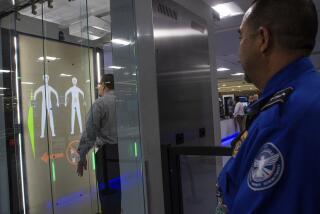INS Plans Fee Lanes at Both U.S. Borders : Immigration: Agency will set up express pay lines at unspecified crossings from Mexico and Canada in a pilot program to begin in the spring.
- Share via
A U.S. Immigration and Naturalization Service official said the agency plans to charge travelers for the use of new express lanes at selected border crossings from Canada and Mxico.
The INS plans to establish a pilot program at a few, unspecified locations along the Mexican and Canadian borders beginning next spring, Duke Austin, a spokesman for the INS in Washington, said Saturday.
To offset the recent increase in traffic at border inspection points, a fee plan was ordered by Congress in the 1991 Appropriations Act, which passed in October, Austin said. The money generated by pay-lane fees would be used to hire additional inspectors and to expand inspection stations. The fee amount for use of optional express lanes have not been determined, Austin said.
The pay lanes would be staffed with additional inspectors to speed border crossings. The special lanes would be available for anyone who is legally eligible to cross the border.
“We are stressing that use of the fee lanes is voluntary,” Austin said. “There will still be non-fee lanes for those who choose not to pay.”
Immigrant rights groups have criticized the revenue-raising method, arguing that INS financial woes are due to internal problems and that more money will not remedy administrative incompetence. Activists also say the fee plan may lead to a tax on anyone entering the country, as is done with international air travel. Such a tax, activists say, would saddle poor migrant workers--who cross the border often and are least able to afford additional expenses--with the brunt of the responsibility to pay for faster inspection service.
The INS disagrees.
“There are two philosophies at work here: Should the general public pay for border inspection service, or just the people who are the users?” Austin said. “This pilot program is about figuring out if the users want to pay for better staffing and quicker service. Let’s see if they’re willing.”
Mario Moreno, an attorney for the Mexican American Legal Defense and Educational Fund, said: “That’s a hell of a way to balance their budget. Charging fees at the border is not the way to take care of the gross mismanagement of the INS.”
In February, the INS plans to submit program guidelines for congressional approval.
Until then, several details need to be resolved, Austin said. Among them:
How will the fees be structured? Are travelers to be charged at each crossing or will the INS issue passes or window stickers entitling the holder to a month or year of express lane use? Will exemptions be extended to low-income travelers? Which inspection stations will have the convenience lanes?
At the San Ysidro-Tijuana inspection station, which is considered one of world’s busiest border crossings, about 50 million people entered the United States last year, the INS said. About 13 million vehicles passed through inspection points. At the Blaine checkpoint, on the Canada-Washington state border, 4.4 million cars were cleared to pass into the United States in 1989.
Lobbyists for the pay lanes estimated that up to $600 million could be raised annually by the fee plan. The 1991 INS budget is $900 million.
More to Read
Sign up for Essential California
The most important California stories and recommendations in your inbox every morning.
You may occasionally receive promotional content from the Los Angeles Times.










